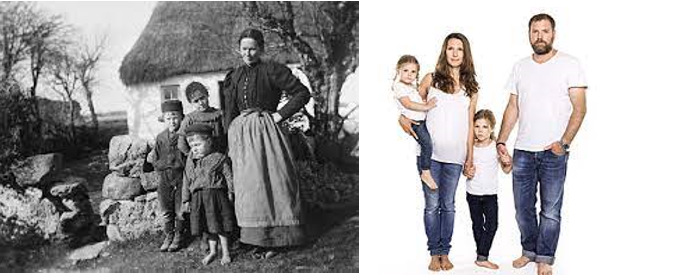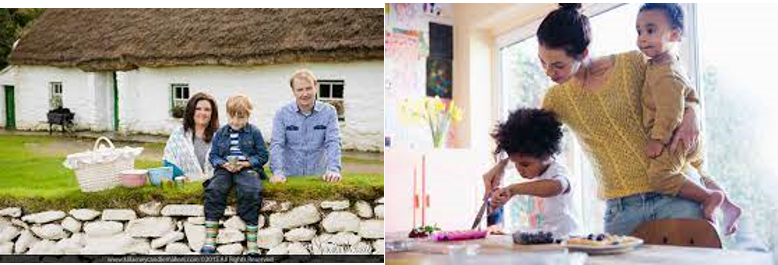Modern families, intimacies, and personal lives in Ireland are, in numerous and diverse ways, dissimilar to those of the previous generations. There are notable changes in the family structures, sizes, and other aspects of the family.
- Family sizes
The number of family members in each family is one of the most notable changes in the Ireland society. According to Goodman (2015), the average size of the family has been on a decline in the last quarter century. Currently, the average family is comprised of one child. The decline in the preference for the number of children in each family is notable from the statistics recorded since the 1990s. In 1991, the average number of children per family was two. In 1996, the average number had declined to 1.8 children per family. A further decline was noted in the 2011 statistics, when the average number was recorded to be 1.4. This research indicates an ongoing trend, whereby people are opting for fewer offspring. It reveals the contrast between the olden and modern societies.
Image 1: Photos of a Irish family in the 1880s and another in 2015 (Earner-Byrne, 2018)
The above image is a photo of an Irish family that dates back to the 1880s. It contains a mother with three children. It is suggests that the number of children in most of the families in the 19th century was about three. The current average is less than half the average of the 1800s. The reduction in family sizes can be attributed to a multiplicity of factors. Amongst them is the increased interaction of people. The theory of symbolic interactionism suggests that people make sense of their social world by interacting with others (Carter & Fuller, 2015). In this sense, the current trend of increased interaction may be contributing to the change in perception about the number of children that a person should have. For example, a large number of people interact a lot in urban settings, and through social media. Their interaction may have led them to adopt knowledge on the need to have few children.
- Family Structures
Unlike in the past, the number of families with unconventional structures have been on the rise in Ireland. According to Seward (2003), Irish families now, more than ever before, are characterized by uncommon structures. Family types are more than they were few decades ago. For example, lone parent families have increased in the past decade. According to Jordan (2020), Ireland is experiencing the highest number of single parents since 2012. The number of households with at least one child but only one parent in the country is higher than that recorded in the UK. The increase in number of single parents reflects the changes taking place in a society that was previously dominated by households with two children. Other family types that have emerged or proliferated in recent decades include childless couples and adopted families. Each of them is a result of different changes taking place in Irish society. For example, the increase in number of marriage breakups is raising the number of single parent families.
Image 2: Images showing a traditional Irish family and a lone parent family (https://www.killarneycandlemakers.com/our-family)
The above images illustrate different family structures. The first depicts the perception of a traditional Irish family. The second shows a family structure with the mother as the sole parent. The contradiction seeks to suggest a change in the family structures in Irish society. According to Seward (2003), the change in family patterns are not necessarily exceptional. They are part of the changes that have been taking place across Europe. Instead, the observation that the changes took place late amongst the Irish people may be attributed to other factors other than the exceptionality of the Irish people. The theory of symbolic interactionism further supports this explanation. It is likely that the late changes in family structures are the results of the increasing interaction between the people of Ireland and other Europeans in the current age of globalization. The Irish people may be accepting the diversified family structures as part of their society due to the observations they have made from their neighboring countries and the conversations that they have been having with their European counterparts.
- Same-sex unions
Amongst the unconventional aspects of Ireland is the legality of same-sex marriages. Unlike in the past, the same-sex relationships in the European country is an accepted norm. According to Hickey (2006), same-sex unions receives massive support amongst members of the public. An overwhelmingly large number of people in the country pressurized the government to recognize gays and lesbians as part of society, and their partnerships as legal. It was after the pressure that votes were casted, and the unions recognized by the constitution of the country. The voting process took place in 2015, making Ireland the first country to legalize it. It was largely celebrated. The country had the opportunity to do so in the past generations, such as in the 1900s. However, the possibility of it happening in the previous centuries was low. Older generations were less inclined towards the mater than the current one. The tendency to embrace or shun the controversial issue delineates their disparities.
Image 3: Photo showing a marriage between a man and a woman and another showing Irish lesbians
The first image shows a man and a woman getting married in Ireland. In the diminishing beliefs of the Irish people, such a union would be considered normal. However, modern society is better depicted in the second photo. The second image shows lesbians after the legalization of same-sex marriages. Their celebratory mode reflects the mood of the community that voted in favor of the legalization of same-sex marriage in the country. The shift towards support for the partnerships in modern Ireland may be attributed to several factors. Amongst them is the increased audacity amongst people to pursue own courses in life. Unlike in the past, more people are willing to take action in ways that do not necessarily adhere to the traditions of society. In this sense, the Irish people engaging in same-sex partnerships are people who are willing to break the norms and beliefs that have been governing behavior amongst the Irish people. Also, support by the relevant parties has provided the necessary enabling factors. For example, the legalization of same-sex partnerships has empowered gays and lesbians to participate in the partnerships without fear of punishment by the government. For this reason, same-sex marriages are a norm in contemporary Irish society, which reciprocates the norms of the past generations.









